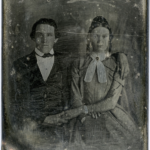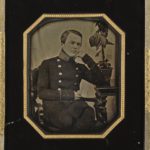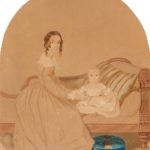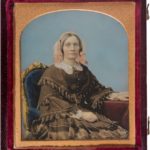Theresa Shepheard Mort (née Laidley) & husband Thomas Sutcliffe Mort, ca.1847
Theresa Shepheard Mort (née Laidley, 1820-1869), colonial spouse, was one of eight children of civil servant James Laidley and his wife Eliza Jane (née Shepheard). Laidley served in the West Indies, Canada and Mauritius before taking up the position of Commissary General in Sydney, arriving with his family in 1827. In October 1841, Theresa married merchant, shipbuilder and wool broker Thomas Sutcliffe Mort (1816-1878). Five years later, Mort purchased land at Darling Point where the family home, Greenoaks, was built. Theresa and Thomas had eight children, seven of whom survived to adulthood. Their eldest son, Laidley James Mort was born at Greenoaks in 1843 and was later educated at Eton. Theresa was a devoted wife and mother and was also an amateur artist, taking lessons from Conrad Martens (who painted Greenoaks) in 1846 and 1847. Thomas Sutcliffe Mort’s biographer has described Mort as having an ‘immense love’ for his wife and family; he is said to have been devastated at Theresa’s death, aged 49, in 1869.
Thomas Sutcliffe Mort (1816–1878) was one of nineteenth- century Sydney’s most prominent businessmen. Born in Lancashire and raised in Manchester, Mort emigrated to New South Wales in 1838, believing that the colony presented ‘a better opening for his industrious habits and his business abilities than there was in the land of his birth’. Within five years he had started his own business as an auctioneer of wool and other commodities – a profession for which his ‘suavity of demeanour, and imperturbable good temper, rendered him eminently fit’. By 1850, he was the premier auctioneer in Sydney and had interests in insurance, agriculture, railway and mining ventures, among others. But he is perhaps most remembered for other initiatives, such as the dairy farms he operated on the estate he acquired at Bodalla in 1860; and the dry dock he helped to establish at Balmain in 1855, which he progressed from shipbuilding to locomotive production and general engineering. He also funded experiments in freezing and refrigeration technology, forming the New South Wales Fresh Food and Ice Company in 1875. Mort donated some of his substantial wealth to community causes, contributing to the building of Sydney’s St Andrew’s Cathedral and the University’s St Paul’s College. Following his death in May 1878, the city marked its esteem for him with a statue in Macquarie Place and Balmain’s Mort Bay was named in his honour.
Theresa Shepheard Mort (née Laidley, 1820–1869) was eight years old when she came to Sydney, her father, James Laidley (1786–1835) having been appointed to the position of deputy commissary general. The eldest of eight children, she was educated at home and received art lessons from Conrad Martens and the ex-convict portraitist, Charles Rodius. Theresa was around twenty-one when she married Thomas Sutcliffe Mort, and twenty-three when her first child, James Laidley Mort, was born. Theresa had eight more children over the next seventeen years; seven of them survived to adulthood. She spent much of her married life at Greenoaks, the Darling Point home established by Mort in 1843. Theresa has been described as a devoted wife and mother and Thomas was devastated by her death from cancer at the age of forty-nine. Mort, however, later remarried, and was to have two more sons before he died.
The figure of Mort in the picture is scarcely the size of a pinkie finger. Yet the energy and enterprise of Mort – wool broker, merchant, financier, shipbuilder, dairy entrepreneur, and pioneer of the technique of freezing meat for export – were tremendous.
Thomas Mort (1816-1878) was born in Bolton, Lancashire, and grew up amidst a close and ambitious middle-class family in Manchester. However, his father failed to prosper in business and died when Thomas was eighteen, leaving the family in rather straitened circumstances. Thomas was working as a clerk with little hope of advancement when he was presented with an opportunity to take up a position in Sydney. He arrived in NSW from England in 1838 to take up a series of clerical jobs with various firms before setting up as an auctioneer in 1843. From this beginning, little more than five years after his arrival in Sydney, Mort established the colony’s main wool auction house, transforming wool auctions from the haphazard and unprofessional affairs they had previously been into a dedicated, streamlined enterprise.
By the end of the 1840s Mort was Sydney’s leading auctioneer, handling more than half the total wool sold in New South Wales. Markets for sheep, cattle and land followed, and soon he began to lend money to pastoralists to fund improvements to their properties, lending more than half a million pounds in 1855 alone. Consolidating his position as the all-round wool specialist and service provider by arranging overseas transport for wool, in the late 1 840s he turned to further export consignments, stock and station agencies, railway promotion, mining and the possibilities of sugar, wine, silk and cotton production. In 1849 he was one of the founders of the AMP Society, established to look after clergymen and public servants in their old age. The following year, he arranged for the colony’s first flock of alpacas to be brought from Peru. After an uncharacteristically unsuccessful investment in mining during the early years of the gold rush, in the mid-1850s he established a dry dock at what is now Balmain. Here he progressed from shipbuilding to general engineering; Australia’s first locomotive was made at Mort’s Dock in 1870. By 1875, Mort’s Dock and Engineering Co had been incorporated, and Mort had become a director of the new Sydney Exchange Co.
Meanwhile, in 1860 Mort had acquired property at Bodalla on the south coast of New South Wales. Here he planned a model estate, clearing, draining, fencing, surveying and re-seeding the land to make it suitable for dairying. After ten years of experimental tenanted share-farming, during which butter and cheese were produced for the Sydney market, Mort reconfigured the land into three farms worked by hired labourers, dramatically increasing the quality of Bodalla’s range of products. Over the period 1866 to 1878 he funded experiments in the production of refrigeration machinery. Although he encountered frustrating failures, and ultimately failed to recoup his huge investment in his chilling ventures, he was able to establish the New South Wales Fresh Food and Ice Company in 1875. The company comprised a slaughtering and refrigeration works in the Blue Mountains, a cold store at Darling Harbour and refrigerated rail compartments for meat and milk. The first consignments of frozen meat were shipped from Australia in 1879, the year after Mort died.
In 1841, Mort married Theresa Shepheard Laidley (1820-1869). Theresa was born in Bridgetown, Barbados where her father, James Laidley, was deputycommissary-general. In 1827 Laidley brought his wife and five children to Sydney, where he succeeded William Wemyss in the Commissariat Department (a branch of the British Commisariat or Treasury, operating as the colony’s market and bank). Soon Laidley was on the council of the Agricultural and Horticultural Society, a foundation member of the Australian Racing Club, and held land at Woolloomooloo Cove and elsewhere, but he died suddenly in 1835 leaving his wife and eight children in considerable financial difficulty. Theresa married Thomas, and her sister Maria married his younger brother, company director, pastoralist and politician Henry Mort, who had followed Thomas to Australia in 1840.
Although they appear remote from each other in this image, Mort’s biographer Alan Barnard has found a good deal of evidence of Mort’s ‘immense love of home, wife, and children’, and theirs for him. He and Theresa had eight children, seven of whom survived to adulthood, and Theresa was a devoted and encouraging wife and mother. Barnard writes that ‘the Mort who was so melancholy before the camera was in fact a cheery soul, the life of the party, the centre of laughter and bright quips, an inveterate talker but one who always attracted a willing hearing.‘ He was urbane and charming, ‘as much at home entertaining the children as he was at public meetings‘. At children’s parties, he played the magician, and even, according to a source quoted by Barnard, “‘with his hands thrust into a pair of Wellington boots, on a table, and with a skilfully arranged curtain and a disguised face … posed as a dwarf, dancing a hornpipe, before the delighted youngsters“‘. Mort was 53, in the midst of a great period of multidirectional expansion, when Theresa died. He was crushed by the loss. However, five years later, he married again, and was to have two more sons before he died. Just days after his death, a party of working men met to discuss ways to commemorate his life. The result was the Mort statue, sculpted by Pierce Connolly, which stands in Macquarie Place, Sydney.
Five years after they were married, the Morts bought land at Darling Point and there built a house they named Greenoaks. Following their visit to England in 1857-9, they returned with a mad assortment of antiques including armour and a job lot of pictures from a sale at Alton Towers, owned by the Earl of Shrewsbury. They subsequently engaged Edmund Blacket, Colonial Architect and a specialist in Gothic ecclesiastical architecture, to design an extension to the house incorporating an art gallery. The gallery and the garden at Greenoaks were open to the public. Mort was an enthusiastic gardener, although his work schedule was such that he sometimes had to tend his plots by candlelight. He won many prizes at flower shows in the 1840s and 50s and in the 1870s he became President of the Horticultural Society of New South Wales. He later commissioned Blacket to design a church on land he had given at Darling Point; it became St Mark’s Darling Point, one of Sydney’s prettiest, and now most fashionable, places of worship. A leading Anglican layman and a conscientious philanthropist from an early age, Mort contributed generously to charities and church in Sydney, subscribing substantially to the construction of St Paul’s College at the University of Sydney and St Andrew’s Cathedral. Greenoaks, now known as Bishopscourt, has served as the official residence of the Anglican Archbishop of Sydney since 1910. Recently, after prolonged battles between the Church and Woollahra Council, part of its grounds was sold off for residential development.
The Mort daguerreotype is intriguing for reasons other than the importance of its sitters. The photographer is unknown, and both the date of the work and its place of origin are mysteries. Before its acquisition in 2001 the Portrait Gallery sought advice from several experts in early Australian photography on the likely date of the image. Family tradition held that it was a portrait taken to celebrate the Morts’ marriage, which would fix the date at 1841. Yet if this date were correct, it would be earliest daguerreotype to have been made in this country. Professional photography in Australia is generally agreed to have begun with the arrival of George Baron Goodman in 1842. This is certainly not a Goodman photograph; his daguerreotypes were relatively crude, whereas the quality of this work is quite high. Alan Davies, curator of photographs at the State Library of New South Wales, observes that given the Mort’s affluence and social position, it is likely that they would have sat for a prominent photographer, not an obscure one. Yet the furniture and style of the image do not match those of any other Australian photograph Davies has seen. It has not been possible for anyone to make out the title of the book on the table between the Morts, which might at least establish the earliest possible date for the work. In Davies’s opinion and others’, the image is more consistent in quality with daguerreotypes made in London in the 1850s. This notion is supported by the bonnet Theresa Mort is holding, which is of a mode popular around 1850, and her dress, which, according to costume authority Margot Ryan, is of a slightly later style. The Morts did visit London in 1857-8. However, as can be seen in the accompanying image, a photograph taken on this visit clearly shows a much older couple. For this reason the National Portrait Gallery has assigned a date of c. 1847 to the work. It is thus of continuing interest as a very early Australian photograph, as well as a fine record of a visionary and magnanimous early Australian entrepreneur.
source: National Portrait Gallery





